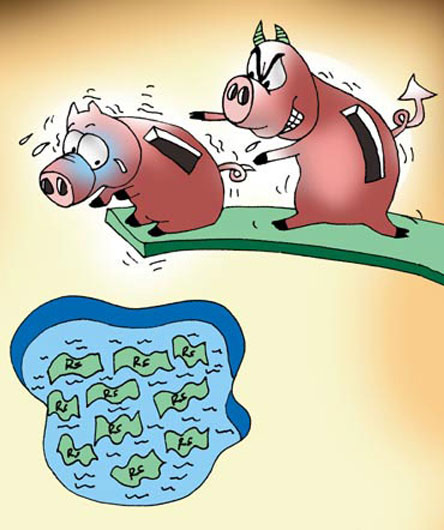Photographs: Uttam Ghosh/Rediff Clifford Alvares
Thirty companies which generated an average RoCE of 30 per cent for five years have seen their market cap rise by 90 per cent
While it’s no surprise the stock market is increasingly sifting between better quality companies and the also-rans, the extent of the rally’s concentration in a few stocks suggests the market is becoming more choosy.
While the stock market has surged 13 per cent year to day and also hit an all-time high recently, only six companies in the 30-stock BSE benchmark, the Sensex, are near their all-time highs. As many as 14 are a little more than 30 per cent away from these.
Experts say a key change in this rally is that investors are seeking out and investing in quality companies, with lower debt and higher returns. Says Raamdeo Agrawal, joint managing director, Motilal: “In the current environment quality companies are a big factor, those with better cash flows, debt management, and sustainable profits.”
Click on NEXT for more...
Check returns on capital before investing
Photographs: Uttam Ghosh/Rediff
Try this measure
One key statistic which can greatly assist investors is the return on capital employed (RoCE). This ratio has a direct impact on the market capitalisation of companies. The higher the ratio, the better the chance that a stock will deliver higher returns in the longer run.
Companies which generated an average return on capital of 30 per cent annually in the past five years have increased their market capitalisations by 89 per cent. Those where the return hovered at 15-30 per cent, on average, saw market capitalisations surge 38 per cent.
Those with a return on capital between zero and 15 per cent saw a decline of 32 per cent. The high returns were generated by adding very little debt as compared to the others (see table: Boom time in cash generators).
A recent report by Ambit Capital on the BSE 200 stocks says Rs 100 invested at the beginning of 2001-02 in the top RoCE quintile (and rebalanced annually) becomes Rs 421 by the end of FY13, based on median returns each year.
On the other hand, Rs 100 invested at the beginning of FY02 in the bottom RoCE quintile delivers only Rs 87 by the end of FY13 (excluding dividends and buybacks). In other words, investors have lost in lower RoCE companies.
Many professional investors go by this measure. With a combination of lower invested capital and higher profitability, businesses reap significant advantages and shareholders significant returns. Says Shah: “Superior capital efficiency and a decent growth of real earnings over a period of time will create outstanding value.”
Click on NEXT for more...
Check returns on capital before investing
Photographs: Uttam Ghosh/Rediff
Why
In his book, Of long-term value and wealth creation from equity investing, Bharat Shah, executive director, ASK Group, refers to this quality of businesses as paramount.
“This is what software firms enjoyed in the decade of the ‘90s and the early part of the last decade. These businesses were, in any case, outstanding free cash machines, enjoyed exceptional RoCE, had rising margins, along with increasing business volumes and improving pricing. Some of the top-notch software firms were generating outstanding RoCE (upwards of 60-70 per cent), along with almost similar profit growth. This is what created a situation in which, in a brief period of four years, firms such as Infosys went up an incredible 140-150 times.”
RoCE combines the best parts of the balance sheet and profit and loss accounts, two crucial elements in a company’s accounts. If the balance sheet is not strong enough, with lower debt, it will reflect in lower return on the capital employed. If the profits are not adequate or there is no significant profitability, the return on capital will also be lower. Both cases are not ideal for investors to make stock investments.
And, both these parameters, lower debt and higher profits, reflect the quality of the management, say experts. Says Agrawal: “A higher RoCE shows the management is of high quality and trying to achieve more efficiency through lesser amounts of capital. These types of businesses do significantly well over time.”
Click on NEXT for more...
Check returns on capital before investing
Photographs: Uttam Ghosh/Rediff
Other checks
Another characteristic of many of these high return companies is ability to pay out better dividends to shareholders. Experts say a high RoCE might be tough for companies to sustain over very long periods if the net worth is expanding.
This would result in lower returns. Hence, these companies also have to give out better shareholder returns through higher payouts from profits to investors.
Another statistic which can be used is to see how much new gross fixed assets a company is investing in, as compared to its cash generated from operations. For example, if total operating profits earned in the past five years is Rs 1,000 crore (Rs 10 billion), ideally it should incur new fixed asset costs that are lower than this amount.
So, in the past five years, its total of fixed assets should not go up beyond, say, Rs 800 crore (Rs 8 billion). If it overshoots the cash generated, the company would have to borrow from the market; it also means it does not generate enough cash to pay back shareholders.
Take Page Industries, for example. This company’s gross block increased by Rs 115 crore (Rs 1.15 billion) in the past four years but its operating profits after paying interest on its loans added to Rs 485 crore (Rs 4.85 billion) in this time.
This leaves enough surplus for it to distribute with shareholders or expand its capacities further with internal accrual. Little surprise the stock surged 56 per cent (compounded annual growth rate) in four years.
Click on NEXT for more...
Check returns on capital before investing
Photographs: Uttam Ghosh/Rediff
In some years, of course, capital assets could suddenly spike up if a company is taking up rapid expansion; so, cash flows in the first few years could take a hit.
But as long as capital invested in the business is at reasonable levels and the cost of capital is kept lower, chances of generating a higher operating cash flow from a business get better. Correspondingly, the return to investors also increases.
Investors would do well to find out good high RoCE companies that are sustainable, combined with lower valuations. Companies that can sustain their returns on capital can be seen from the longer term borrowing history.
Experts say companies that come to the market for regular capital infusions are not able to keep their balance sheets leaner and efficient. In the initial periods, capital infusion might give a boost to their businesses and earnings growth.
Enhancing value
- What investors should look for is a combination of higher returns on capital employed, with higher earnings growth. This is the best potential combination for higher possible value creation
- On the other hand, higher return on capital and lower earnings growth might maintain the business but won’t help value creation. A lower return on capital and lower profitability might lead to value destruction
- Experts say by using this measure, along with a lower price-earnings ratio, investors can greatly increase their chances of making winning stock market investments







article